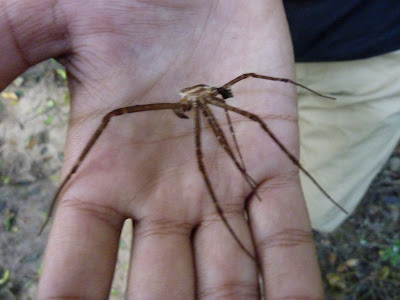Elephant escapes from Top Slip camp, search on
TNN, Feb 24, 2011, 05.38am IST
COIMBATORE: A 35-year-old tusker has escaped from the elephant camp at Top Slip near Pollachi in Coimbatore district.
It slipped out of the camp on Monday night and is hiding in the bushes near Sethumadai, a little away from the reserve forest area. The tusker, Karthik is going through "must" and may have gone in search of a female companion, S Thangaraj, a forest ranger at Top Slip, told The Times of India.
Normally, the elephants at the training camp are not bound by chain at night. They're let loose in the forests. In the mornings, they return to the camp. "Elephants have never slipped out of the camp in the last decade," said Thangaraj.
The mahout and forest guards launched a massive search for the animal on Tuesday. They spotted him at a tribal settlement in Saralapathy near Sethumadai on Wednesday morning. When the mahout Murugan walked closer to the tusker, the animal ran deeper into the jungles. His female companion, Sivakami, and another tusker were brought in to lure him back into the camp. "But he is refusing to come out of the bushes," Thangaraj said.
By dusk, the "rescue operation" was called off. Now, forest officials are trying to trap Karthik with two other female elephants in the camp. "He relates well to our camp elephants Vijayalakshmi and Selvi. We hope Karthik will come back tomorrow," the official said.
Karthik was born in the Top Slip camp to Alamelu, who died a few years ago. When wild tuskers stray away from jungle, Karthik usually goes as a kumkhi elephant to drive them back. There are 20 elephants in the Top Slip camp.
Radha Venkatesan | TNN, Feb 25th
Coimbatore: In a fierce territorial fight in the jungles, a male elephant which escaped from the elephant camp at Top Slip near Pollachi was gored by a wild tusker on Thursday morning. The 35-year-old camp elephant, Karthik, was found dead with multiple bleeding injuries at Saralapathy near Sethumadai, about 5 km from the scenic hill retreat of Top Slip.
“His body was covered with bleeding wounds. He was gored to death in a fierce fight with a large wild tusker,” Top Slip forest ranger, Thangaraj Paneerselvam told TOI.
Forest guards who had waited on the forest fringes to bring back the tusker to the camp, could hear loud trumpeting all through Wednesday night. Around 4am on Thursday, the trumpeting stopped.
“We knew Karthik was in trouble. But when we went into the jungles, it was too late,” Karthik’s mahout Murugan said. When a camp elephant strays into forests, it cannot co-exist with wild elephants. “A camp elephant is no match for a wild tusker. The tusker is fiercely territorial and will not allow camp elephants to invade his space,” the forest official said. Karthik was born in the elephant camp about 35 years ago and was a “kumkhi” elephant.
On Monday night, suffering from hormonal surges, he left the camp. Forest guards and mahouts launched a massive hunt in the jungles to locate him.
After a day-long search, they spotted him near a tribal settlement at Saralapatty. However, he refused to respond to the calls of his mahout. So, a female elephant, Sivakami, and another tusker from the Kozhikamudi camp were brought to lure him out of the jungles.
But Karthik stubbornly ignored the overtures of Sivakami and ran deeper into the jungles. On Wednesday evening, the forest personnel decided to bring two more female elephants to draw Karthik back to the camp. “Unfortunately, by this time, Karthik had succumbed in a terrain battle. The tusker which attacked him was also experiencing hormonal surges,” forest guards said.
Two years ago, two elephants in the camp fought a fierce battle and one of them died after suffering severe abdominal injuries. Last week, a tiger and a leopard died in a territorial fight in the Nilgiris forests.
radha.venkatesan@timesgroup.com
radha.venkatesan@timesgroup.com




 Coppersmith barbet - Megalaima haemacephala
Coppersmith barbet - Megalaima haemacephala White-breasted kingfisher - Halcyon smyrnensis
White-breasted kingfisher - Halcyon smyrnensis Argiope anasuja. Photo by Junior, with his 35mm Nikon camera and manual focus
Argiope anasuja. Photo by Junior, with his 35mm Nikon camera and manual focus The same argiope, taken by me with the Panasonic Lumix on autofocus. I struggled to get it into focus, as the camera "autofocussed on everything else besides this spider! Reminded me of Dr TPA and the Photography workshop I attended.
The same argiope, taken by me with the Panasonic Lumix on autofocus. I struggled to get it into focus, as the camera "autofocussed on everything else besides this spider! Reminded me of Dr TPA and the Photography workshop I attended. I think this is the Opadometa fastigata, with silver patches across the body
I think this is the Opadometa fastigata, with silver patches across the body Gasteracantha geminata. A common spider of Kerala
Gasteracantha geminata. A common spider of Kerala
 A smiling mum and her baby, all mud bathed
A smiling mum and her baby, all mud bathed To be wild and free
To be wild and free The sad face of a camp elephant. Why do their trunks and ears look so "scrubbed"?
The sad face of a camp elephant. Why do their trunks and ears look so "scrubbed"?
 Those horrible, horrible chains...like prisoners
Those horrible, horrible chains...like prisoners It is no wonder that this elephant in the wild walked off into the forest on seeing us. They cannot possibly view us with ease. Click on the photo and look in the centre you will see an elephant
It is no wonder that this elephant in the wild walked off into the forest on seeing us. They cannot possibly view us with ease. Click on the photo and look in the centre you will see an elephant
 Nice mohawk isn't it?
Nice mohawk isn't it?




